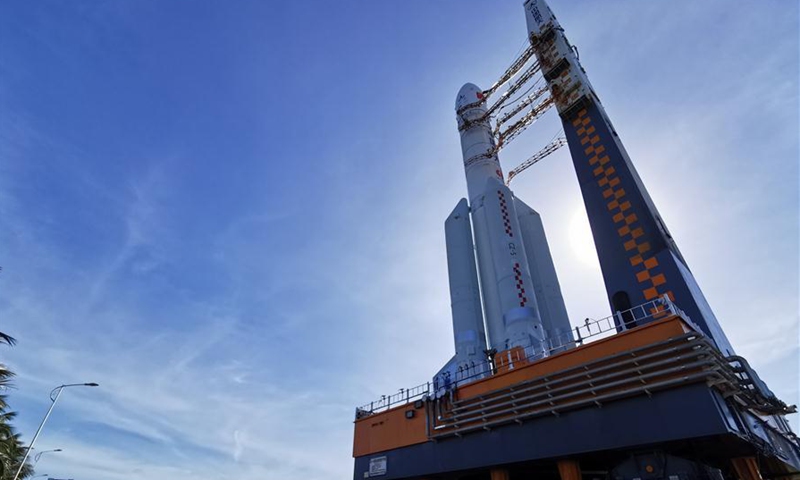Chinese relay satellites, deep-space ground stations ready for upcoming Mars mission
By Deng Xiaoci Source: Global Times Published: 2020/7/20 20:13:40
00:00:00
/ 01:27
To ensure a successful launch of the Long March-5 Y4 carrier rocket for China's first Mars probe mission, the country's space-borne spacecraft monitoring and control team has completed preparation work, including adaptive adjustments to the Tianlian relay communication satellites and deep-space ground stations in Northeast and Northwest China.
The two relay communication satellites are now in their "optimum condition" ahead of the Tianwen-1 launch mission, the team said in a statement sent to the Global Times on Monday.
Tianlian satellites are China's data tracking and relay communication satellites that fly in the geostationary orbit. They are mainly tasked to provide data relay, measurements and control, and transmission services for the in-orbit spacecraft on a global scale.
In the Tianwen-1 launch mission, the team will operate the two satellites to provide remote measurements and data relay services for the Long March-5 Y4 carrier rocket.

Photo taken on July 17, 2020 shows the Long March-5 rocket at the Wenchang Space Launch Center in south China's Hainan Province. The Long March-5 rocket, to be used to launch China's first Mars exploration mission, was vertically transported to the launching area at the Wenchang Space Launch Center in south China's Hainan Province on Friday. The carrier rocket, coded as Long March-5 Y4, is planned to be launched in late July or early August, according to the China National Space Administration. (Photo by Zhang Gaoxiang/Xinhua)
The Long March-5 Y4, the carrier rocket commissioned for the probe, was vertically transported to the launch area at the Wenchang Space Launch Center in South China's Hainan Province on Friday morning ahead of the launch scheduled to take place between the end of July and the beginning of August, the China National Space Administration (CNSA) said.
A highly stable and reliable information link between the satellites and the Wenchang Space Launch Center has been built, the team noted.
The minimum distance between Mars and Earth is about 55 million kilometers, and the two planets only come that close every 26 months, state-owned space giant China Aerospace Science and Technology Corporation (CASC), the mission's contractor, said in June. The Mars exploration window is open between July and August.
The Tianwen-1 Mars probe mission was approved by Chinese authorities on January 2016, and aims to achieve orbiting, landing and roving on the Red Planet in a single mission.
The launch will be the fourth of the Long March-5, following the successful return of the state-of-the-art rocket at the end of last year, more than two years after a July 2017 launch failure on the rocket's second test flight due to engine problems.
Earlier on Tuesday, media reported that the spacecraft developer, the China Academy of Space Technology, said the Mars probe had arrived at the Wenchang Space Launch Center.
Pang Zhihao, a Beijing-based space expert who has been closely following the mars mission, told the Global Times on Monday that the Tianlian satellites are mainly tasked to provide communications service, and as the rocket enters the Earth-Mars transfer orbit, the deep-space antenna in the ground stations will take over.
According to the Xi'an Satellite Control Center on Monday, the center will deploy the deep-space control stations in Jiamusi, Northeast China's Heilong Jiang Province and in Kashi prefecture, Northwest China's Xinjiang Uygur Autonomous Region.
The Mars probe will travel as far as 400 million kilometers into deep space, and the Earth-Mars transfer flight will take almost seven months.
Automatic operation modules have been installed at the two ground stations to further alleviate human resource pressure.
Hosting work of a new radar array system, which includes four 35-meter antennas, has been completed and the system will join service by the end of this year, further boosting the country's deep space probe capability, Global Times learned from the Xi'an center.
The Jiamusi and Kashi stations have jointly completed a number of space missions. These include the Chang'e-3, 4 lunar probes. And the Jiamusi station has the largest antenna in Asia, with a diameter of 66 meters. According to the center, the antenna can support a spacecraft tracking mission as far as 4.76 billion kilometers.
China is also building a 70-meter reflector antenna for the Mars exploration mission in Wuqing district, Tianjin.
As the key equipment for receiving the data from the Mars exploration, the high-performance antenna is 72 meters high and weighs 2,700 tons. Composed of 1,328 high-precision panels, it is about the size of nine basketball courts with the diameter of its main reflector as wide as 70 meters.
The equipment is expected to receive data from Mars by October this year, Global Times learned from the National Astronomical Observatories (NAOC) of the Chinese Academy of Sciences in April.
Newspaper headline: China ready for first Mars mission
RELATED ARTICLES:
Posted in: SOCIETY,CHINA FOCUS